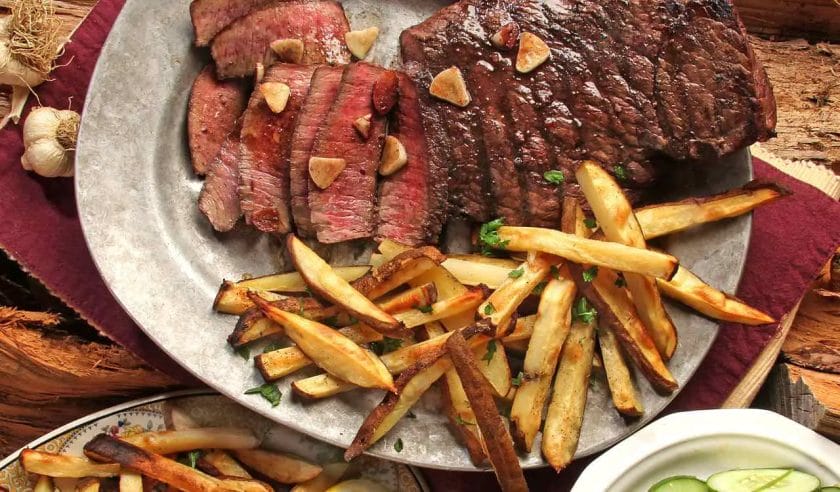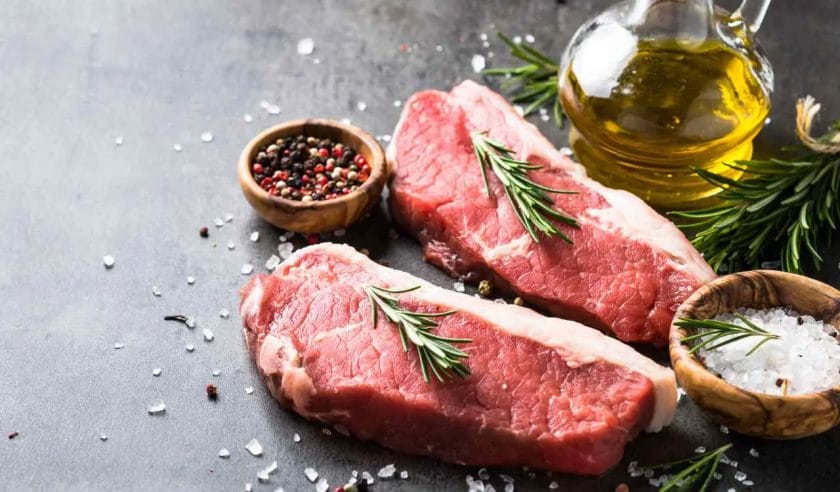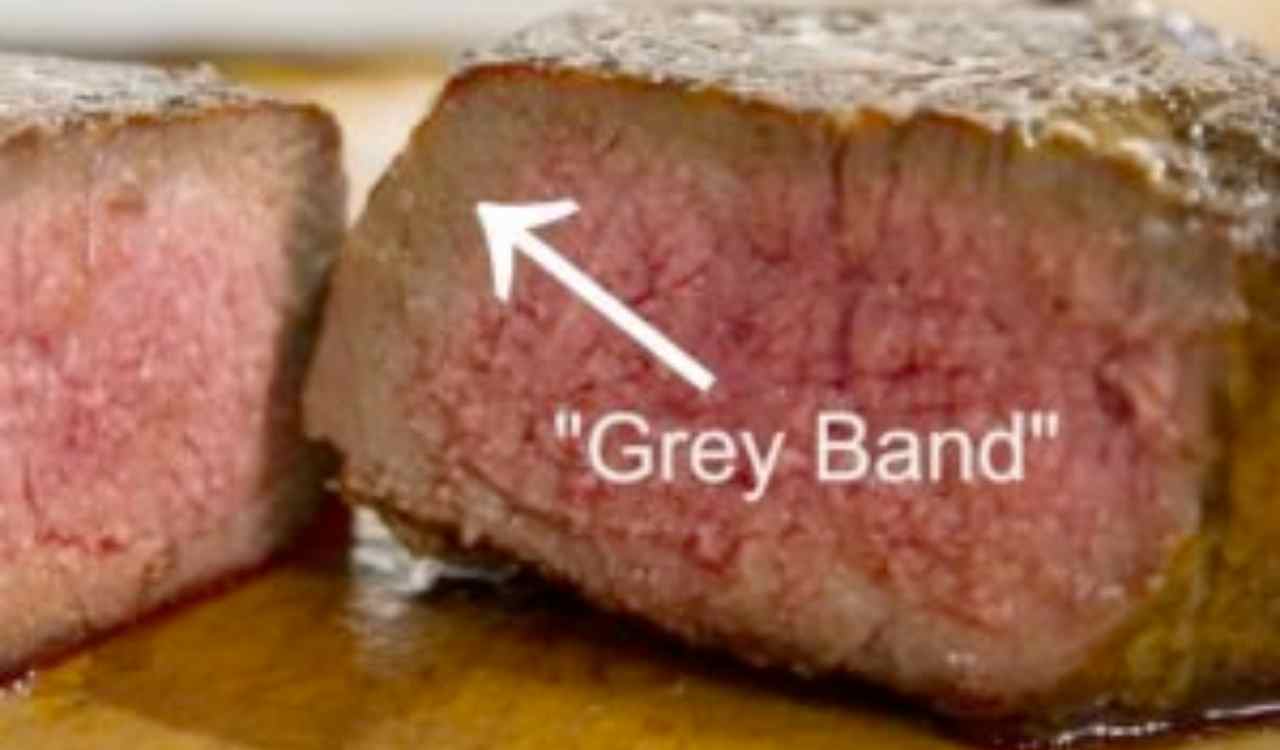Picture this: you’re ready to cook a delicious steak for dinner, but when you take it out of the fridge, you notice that it has turned gray.
Panic sets in as you wonder if it’s still safe to eat. Don’t worry, you’re not alone in this concern. Many people question whether gray meat is still good and fit for consumption.
In this article, we’ll dive deep into the subject of meat discoloration and provide you with the knowledge you need to make an informed decision. Let’s unravel the truth behind gray steak and understand its implications for both safety and taste.
Understanding Meat Discoloration
Meat discoloration can be disconcerting, especially when it comes to steak, which we often associate with a vibrant red hue. To understand why meat changes color, we need to explore the factors that contribute to this phenomenon.
1. Oxygen Exposure and Meat Color
One of the primary culprits behind meat discoloration is oxygen exposure. When meat comes into contact with oxygen, a chemical reaction occurs that alters its color. This process is known as oxidation.

Oxygen reacts with a protein called myoglobin, which is responsible for giving meat its red color. As oxygen interacts with myoglobin, it causes a breakdown in the structure of the protein, leading to a change in color.
2. The Role of Myoglobin
To understand meat color changes, it’s essential to grasp the role of myoglobin. Myoglobin is a pigment found in muscle tissues, and its function is to bind oxygen and help transport it to the muscles.
Myoglobin is what gives meat its red color when it’s freshly cut and exposed to oxygen. However, as the oxygen supply diminishes, myoglobin undergoes chemical changes, resulting in the meat appearing less red.
Gray Steak: Causes and Assessment
Gray steak can occur for various reasons, and it’s crucial to assess the cause and understand the implications it has on the meat’s quality.
1. Extended Oxygen Exposure
One common cause of gray steak is prolonged oxygen exposure. When steak is left exposed to air for an extended period, the myoglobin in the meat undergoes further oxidation.
As a result, the red pigment diminishes, and the steak may appear gray or brownish in color. It’s important to note that extended oxygen exposure doesn’t necessarily mean the steak is unsafe to eat, but it can affect the taste and texture.
2. Other Factors Leading to Grayness
Apart from extended oxygen exposure, aging and improper storage can also contribute to grayness in steak. As meat ages, the color naturally changes, and it may develop a gray tint.
Similarly, if steak is not stored properly, such as being kept at incorrect temperatures or exposed to light, it can lead to accelerated discoloration. These factors should be taken into account when evaluating the quality of gray steak.
Is Gray Steak Safe to Eat?
The most crucial question that arises when encountering gray steak is whether it is safe for consumption.
While visual appearance can provide some indications, it’s essential to understand the difference between the color and the safety of the meat.
1. Visual Appearance vs. Food Safety
It’s important to remember that the color of the meat is not the sole indicator of its safety.
The appearance of grayness or a change in color does not necessarily mean that the meat is spoiled or unsafe to eat. Meat can undergo natural chemical and microbial changes without displaying visual signs of spoilage.

2. Microbial and Chemical Changes
Although gray steak may still be safe to eat, it’s crucial to consider microbial and chemical changes that may have occurred. When meat is exposed to oxygen for an extended period, it creates an environment conducive to microbial growth.
Bacteria, if present, can multiply and potentially lead to foodborne illnesses. Additionally, the breakdown of myoglobin and the oxidation process can affect the taste and texture of the meat.
3. Signs of Spoilage
To determine the safety of gray steak, it’s important to look for specific signs of spoilage. These signs include an off-putting odor, sliminess, excessive moisture, or an unnatural greenish or yellowish tint. If any of these signs are present, it’s best to discard the meat.
4. Proper Food Handling and Storage
To minimize the risk of grayness and ensure meat safety, proper food handling and storage practices are essential.
Always store meat at the recommended temperatures, separate raw meat from other foods, and use it within the appropriate timeframe. Thaw meat in the refrigerator or using the cold-water method to avoid unnecessary exposure to oxygen.
By understanding the difference between visual appearance and food safety, and by practicing proper food handling and storage, you can minimize the chances of encountering gray steak and ensure the safety of the meat you consume.
V. Maintaining Meat Quality and Color
Now that we’ve discussed the concerns surrounding gray steak, let’s explore some strategies to maintain meat quality and color.
By following these tips, you can ensure that your steak stays fresh, visually appealing, and safe for consumption.
1. Selecting Fresh Steak
Choosing fresh steak is crucial to minimize the chances of encountering grayness. When purchasing steak, consider the following factors:
- Color: Look for steak that has a bright red color. Avoid meat that appears dull or grayish.
- Texture: The meat should feel firm to the touch and have a moist surface. Avoid steak that feels slimy or sticky.
- Smell: Fresh steak should have a neutral, meaty odor. If there is any unpleasant or sour smell, it may indicate spoilage.
By paying attention to these qualities, you can select high-quality steak that is less likely to turn gray prematurely.
2. Proper Storage Methods
Proper storage is essential to maintain meat color and prevent discoloration. Follow these guidelines:
- Refrigeration: Store steak in the refrigerator at temperatures below 40°F (4°C). Keep it tightly wrapped or sealed in airtight containers to minimize oxygen exposure.
- Freezing: If you’re not planning to use the steak within a few days, consider freezing it. Wrap the meat tightly in freezer-safe packaging to prevent freezer burn and oxidation.
- Packaging: Vacuum-sealed packaging can help preserve the color and quality of the meat by reducing exposure to oxygen. Alternatively, use airtight containers or zipper-lock bags to store steak.
Remember to label the packaging with the date of purchase or freezing to ensure you use the steak within a safe timeframe.
3. Safe Defrosting Practices
Improper defrosting can contribute to grayness in steak. Follow these safe defrosting practices:
- Refrigerator thawing: Thaw steak in the refrigerator by placing it on a plate or tray to catch any drips. This slow thawing process ensures a gradual temperature increase, reducing the risk of bacterial growth.
- Cold-water thawing: If you need to thaw steak quickly, submerge it in airtight packaging in cold water. Change the water every 30 minutes to maintain a safe temperature.
Avoid thawing steak at room temperature, as it can lead to uneven thawing and increased microbial growth.
4. Cooking Techniques
Proper cooking techniques can help preserve the visual appeal of your steak. Consider the following tips:
- Searing: Searing the steak at high heat can create a flavorful crust and enhance its appearance.
- Grilling and broiling: These methods can help retain the natural juices and contribute to a visually appealing charred exterior.
- Sous vide cooking: This method involves vacuum-sealing the steak and cooking it in a water bath at a precise temperature. Sous vide cooking helps maintain the meat’s natural color and juiciness.
By using these cooking techniques, you can enhance the visual appeal of your steak and ensure a delicious dining experience.
VI. Conclusion
Grayness in steak can be a cause for concern, but understanding the underlying factors can help you make an informed decision about its safety and quality. Remember that visual appearance alone is not a definitive indicator of spoilage or safety.
By following proper food handling, storage, and cooking practices, you can minimize the chances of encountering gray steak and ensure that the meat you consume is safe and delicious.
Next time you come across a gray steak, assess its overall condition, including odor and texture. If it appears to be in good condition and doesn’t exhibit signs of spoilage, it may still be safe to eat. However, if you’re unsure or notice any off-putting signs, it’s best to err on the side of caution and discard the meat.
By being aware of the causes of meat discoloration, practicing proper food safety measures, and implementing strategies to maintain meat quality, you can enjoy flavorful and visually appealing steak without worry. So, fire up that grill or sharpen your knives, and savor the delights of a perfectly cooked, safe, and scrumptious steak!
1. Can I eat gray steak if it smells okay?
While the smell of the steak is an essential factor to consider, it should not be the sole determinant of its safety. Gray steak that smells okay may still pose a risk of bacterial growth and potential foodborne illnesses. It is important to assess other factors such as texture, moisture, and overall appearance before deciding whether to consume it.
2. What should I do if my steak turns gray during cooking?
If your steak turns gray during cooking, it may indicate overcooking or insufficient heat reaching the interior. Overcooked steak can result in a loss of moisture, which can make it appear grayish. To prevent this, monitor the cooking temperature, use a meat thermometer to ensure proper doneness, and avoid overcooking the steak.
3. How can I prevent my steak from turning gray in the refrigerator?
To prevent steak from turning gray in the refrigerator, ensure it is stored properly. Wrap the steak tightly in plastic wrap or place it in an airtight container to minimize exposure to oxygen. Additionally, make sure the refrigerator temperature is set below 40°F (4°C) to slow down bacterial growth and maintain the meat’s quality.
4. Can grayness in steak be an indicator of spoilage?
Grayness in steak can sometimes be an indicator of spoilage, but it is not always the case. While gray coloration can result from extended oxygen exposure or natural aging, it does not necessarily mean the meat is spoiled. It is important to consider other signs of spoilage, such as an off-putting odor, sliminess, excessive moisture, or an unnatural greenish or yellowish tint.
5. Can freezing steak cause it to turn gray?
Freezing steak can cause changes in color, but it does not necessarily mean the meat is unsafe or spoiled. Freezer burn, which occurs when moisture in the meat evaporates, can lead to a grayish appearance. To prevent freezer burn, ensure the steak is properly wrapped in freezer-safe packaging to minimize moisture loss and exposure to air.
6. Does marinating steak prevent it from turning gray?
Marinating steak does not prevent it from turning gray, as discoloration primarily occurs due to the breakdown of myoglobin and oxygen exposure. However, marinating can enhance the flavor of the steak and help tenderize it. Choose acidic or enzymatic marinades that can penetrate the meat and impart flavor, while also minimizing cooking-induced discoloration.
7. Can I eat gray steak if it has been in the refrigerator for a few days?
The duration that steak can be safely stored in the refrigerator depends on various factors, including the initial quality of the meat, proper storage conditions, and safe handling practices. While a grayish appearance may develop after a few days, it is essential to consider other signs of spoilage. If the steak exhibits any off-putting odors, sliminess, excessive moisture, or abnormal coloration, it is best to discard it to avoid the risk of foodborne illnesses.
8. Does the type of steak affect the likelihood of it turning gray?
The type of steak does not significantly affect the likelihood of it turning gray. Discoloration is primarily influenced by factors such as oxygen exposure, storage conditions, and handling practices, rather than the specific cut of meat. However, certain cuts may have a higher fat content, which can impact the appearance and texture of the cooked steak.

